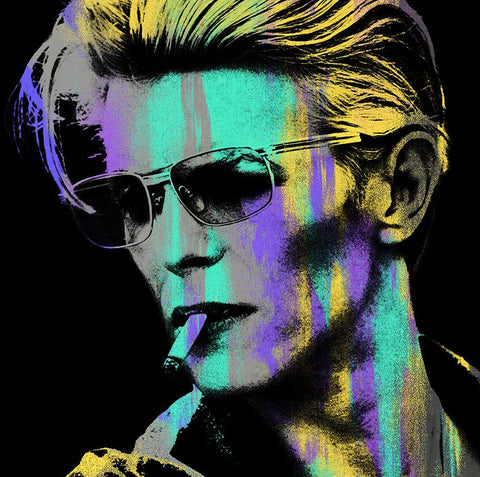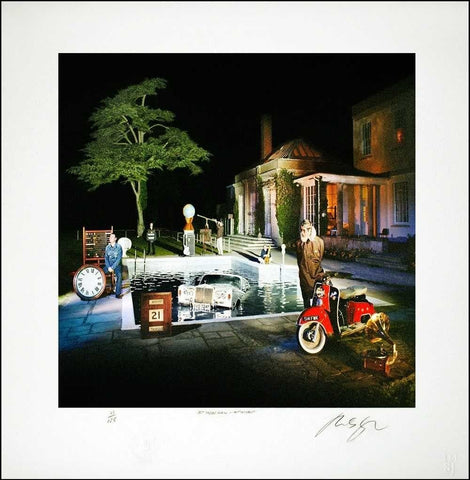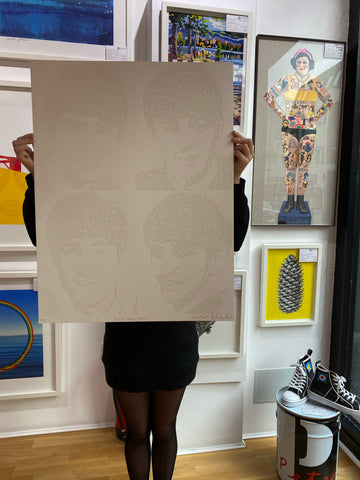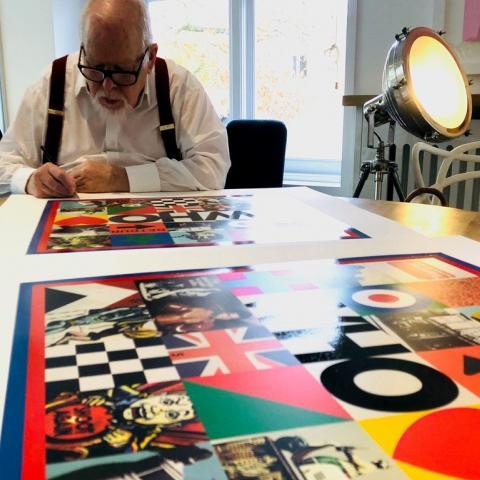Art and artists have always been fascinated by the idea of celebrity. Of being a recognisable name, of being an individual that is influencing and defining a generation.
Some artists went to great lengths to ensure that kind of notoriety themselves. Dali was certainly one of them, making sure that he as an artist was also a celebrity with a lot of celebrity friends. Dali spent his time with John Lennon, David Bowie, and even invited Cher round when he was hosting an orgy.
Wrapped up in the idea of a celebrity and art is influence. Those individuals who created a movement with their music will naturally draw the fascination and curiosity of artists. In the space where a celebrity becomes an icon is where art resides. Art can be the catalyst to immortality. An album cover can become symbolic and carry their influence further than the stages that they performed on, on t-shirts, on mugs, on flags, everywhere. 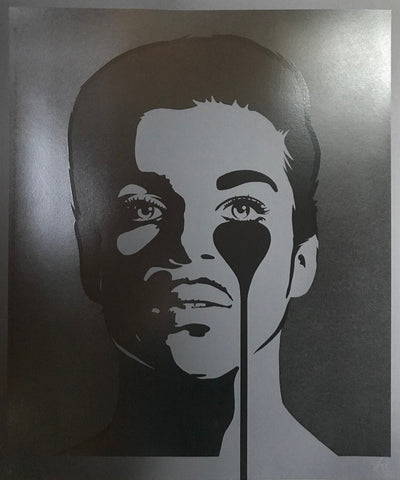
Art can become a magnifying glass to cast upon these often shrouded, enigmatic figures, endeavoring to discover who they really are. Art can become a pedestal to hold up these immensely talented and accomplished individuals even further, to commemorate their life and work. Or art can just have a bit of fun with universally recognisable faces
One artist that definitely (maybe) has fun with celebrity iconography is Michael Spencer Jones. His career has been defined by working with Oasis and The Verve as a photographer and video director, as is showcased in his cinematic catalogue of work. Often known as Oasis’ official photographer, his familiarity with the musicians shines as his work is theatrical but with a sense of familiarity. Although it is hard to imagine Liam Gallagher doing anything he doesn’t want to do, Jones opts to rebel against the public perception of the star in this piece.
Be Here Now portrays the rock n roll stars as laid back, indifferent, contrasting with the destructively decadent background. A real Rolls Royce was submerged into a pool at Stocks House in Hertfordshire, where many outrageous parties were thrown in the 1970s. The piece is a snapshot of British hedonism, of pop culture and music history. A perfect album cover, elegance and debauchery in equal measure. Not without a parka, of course. You can’t take Manchester out of the star.
Artist Anthony Freeman specialises in iconography. His body of work comprises of famous faces with his own distinct style. He takes classic black and white images of celebrity portraits and interlays them with a selection of electric hues.
One foot in the past where they made their legacy, and one foot in the future where they’ll be remembered. The result is a fresh way of commemorating the greats, Freeman’s art pays homage to the essential timelessness of icons.

Pakpoom Silaphan is an artist who takes the notion of celebrity iconography and twists it into something different altogether. His piece, Bob Dylan on Fanta AP, draws upon a range of influences to give a fresh take on the visual power of icons. His influences of Warhol and Dali are woven in the hazy overlaying of advertisement, sketch and photograph.
Silaphan grew up in Bangkok and his work displays a perspective of how celebrity culture is received in the east that is rarely expressed in art. Mixed with a vintage Fanta ad, the image of Bob Dylan is out of place, barely there, more of an outline yet with a distinct face. Almost a fever dream of imagery, it portrays old television advertisements being somehow paused in-between a Dylan album promotion and a Fanta ad. A comment perhaps on the commodification of celebrity culture, Silaphan viscerally explores mass consumerism in his rich surrealistic piece.
When art attempts to capture the essence of a celebrity it runs the risk of being reductive. Iconography flattens the human and turns them into a symbol.
Mike Edwards brings his own form of iconography that refuses to let celebrities be turned into art without making the viewer remember exactly why they became famous in the first place.
The viewer is initially struck with the overall image of the celebrity, and then the piece shifts in perspective. The focus turns onto the lyrics that he constructs his work with, offering another kind of visual experience entirely.
The text is an inspired extension of the original lyrics, often edited or mixed with other words associated with the subject. By combining this with a masterful use of font, colour and form, he creates a unique kind of tribute.
The poignancy of the words sing out, as Edwards carefully highlights particular words that quickly flash across the mind like a memory. Edwards creates much more than an artist tribute with his work, he creates a poignant experience of their work in his. Art within art.
It’s difficult to think of an artist that is more renowned for their work with musicians than Sir Peter Blake. Blake’s work with the Beatles is renowned across the globe, as he designed the album cover for Sgt. Pepper’s Lonely Hearts Club Band and continues to be inspired by contemporary celebrity culture in his work. His piece PS I Love You depicts those old favourites The Beatles in diamond dust on silkscreen.
PS I l Love You is a departure from his usual technicolour style. Monochromatic is somewhat an understatement, with the only material used to define the forms of those famous four are the iridescent sparkles of diamond dust. His choice of medium is fascinating here, perhaps a humorous spin on the ‘stars in your eyes’ affect that celebrities have.
The piece also aptly portrays the reality of stardom, that once you reach a certain point of fame, everything that you touch turns into gold. In this case, diamonds. Stars depicted in stars, Blake’s twinkling wonder of a piece is both beautiful and sincere.

His union with music is very much in the name. Tape Deck Art produces historical art with his badges. Visually commemorating cultural movements in British history, namely punk in the 1970s and 80s. By choosing to honour the badge, Tape Deck also honours the original fans of the bands. Whether its The Sex Pistols, The Clash or The Smiths, everyone who was loved them at the time had a badge.
So closely wrapped with identity, a badge is a personal statement about who you are. Often in this case it was about being much more than a fan, but showing a belief in a counterculture, of rebellion and non-conformism. Turning badges into wall art celebrates the movement that those bands created and all of the people that they inspired. For many, his work will be a welcome nostalgia trip to their own experience of that time.
Electric colours are hand painted and every badge is unique and different. Tape Deck elevates the long held tradition of celebrity merchandise by turning it into stunning art that helped to lead a cultural movement of punk rock in Britain during the 1970s.
Enter Gallery are getting our hands on an exclusive The Who badge from Tape Deck in the very near future, so watch this space! The Prodigy x Tape Deck badges sold out in four minutes, so Tape Deck has also kindly made us an AP of the badge for anyone that missed out. Meet Tape Deck Art and find out more about these new releases here.

